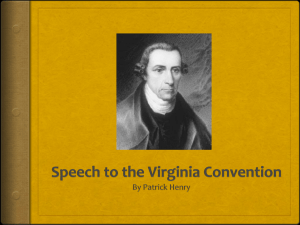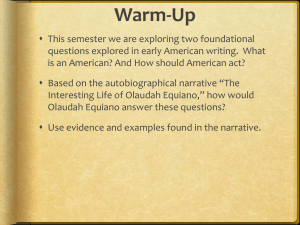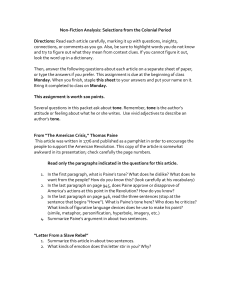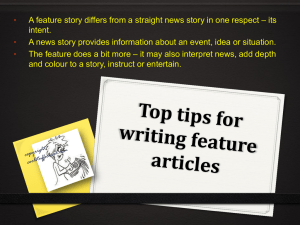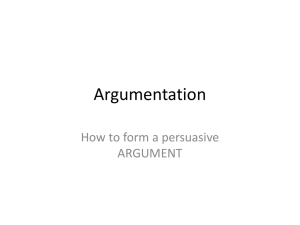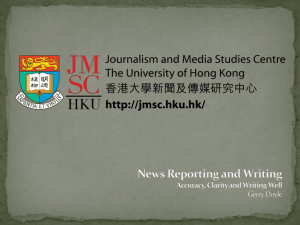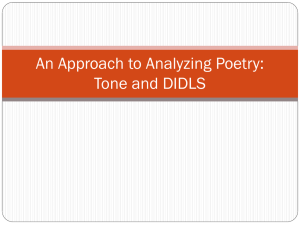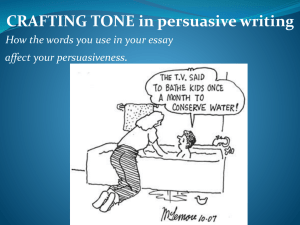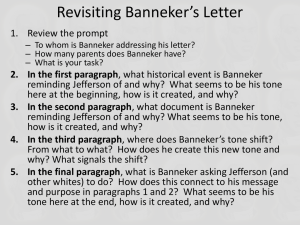Declaration of Independence
advertisement
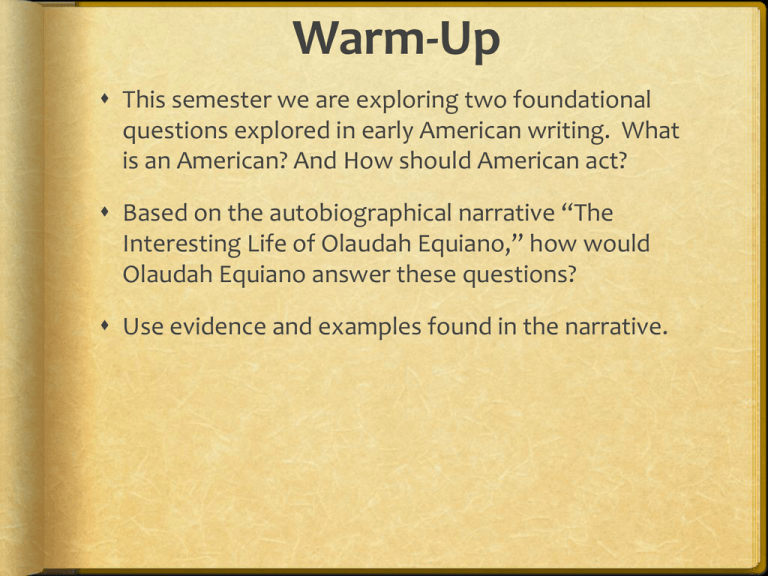
Warm-Up This semester we are exploring two foundational questions explored in early American writing. What is an American? And How should American act? Based on the autobiographical narrative “The Interesting Life of Olaudah Equiano,” how would Olaudah Equiano answer these questions? Use evidence and examples found in the narrative. During Today’s Lesson OBJECTIVE: By practicing CLOSE READING strategies, SWBAT identify Thomas Jefferson’s use of LOADED WORDS, PARALLEL SRUCTURE and rhetorical triangle in “The Autobiography of the Declaration of Independence” to justify American rebellion against the British and persuade fellow Americans to join the revolution. Evidence of your learning will be shown through: Annotations and Marginalia Dialectical journal and summary. Progress Check During Today’s Lesson Learn about the process of drafting the Declaration of Independence and how it shows and attempt to answer the questions “What is an American? How should an American act?” Identify the purpose, tone, and stylistic devices within Thomas Jefferson’s political treatise against the British crown. EARLY AMERICAN WRITING Sermons Autobiographies Political Documents Journals/Diaries After you watch preview video, use circle map info to write background paragraph. Use the following paragraph frame: As you watch video, fill in circle map with important information about Author’s background. Thomas Jefferson _______can be described as ______. He was born ________ and spent most of his life________. While ________, he became interested in ________. Additionally, ________________. His writing attempts to ______________ by _______________. PARALLELISM A.K.A. Parallel Structure The repetition of words, phrases, clauses, or sentences. For example, in The Declaration of Independence Jefferson cites truths that are “self-evident,” he begins each clause with “that.” He also begins a long series of paragraphs with the words “He has.” Jefferson’s use of parallelism creates a stately rhythm or cadence. Listen for this as you read. Tone: the attitude a writer takes toward the subject of a work Objective (Informational) v. Subjective (Emotional) Tone is dependent on diction (word choice) and style. Style: The distinctive way in which a writer uses language. This includes sentence length, complexity, syntax, figurative language and word choice. Formal v. Infomal TONE TOOL: Use this to help you identify specific tone of a text. Step 1: Is it neutral, positive, or negative? Step 2: Go through the list and find appropriate and specific word. Let’s practice… Predict: What is the tone? style? “Prudence, indeed will dictate that governments long established should not be changed for light and transient causes...” … “Such has been the patient sufferance of these colonies; and such is not the necessity which constrains them to expunge their former systems of government.” … “He has abdicated government here withdrawing his governors and declaring us out of his allegiance and protection.” “He has incited treasonable insurrections of our fellow citizens, with the allurements of forfeiture and confiscation of our property.” “These facts have given the last stab to agonizing affection, and manly spirit bids us to renounce forever these unfeeling brethren.” Predict: What is the tone? “We will tread it apart from them and acquiesce in the necessity which denounces our eternal separation.” First read… Number the Paragraphs. Look at the title and use your background knowledge to predict what author will be arguing in this essay. Quick-Read: 3 minutes Skim through the article and circle KEY words that convey tone and seem important to what he will be arguing or communicating. Second: ANNOTATE Teacher reads TWO PARAGRAPHS AT A TIME. Leaves one minute for student to do the following: Underline sentences that help you understand the author’s argument and purpose. Use the following questions to guide your annotations. What is the author’s argument? Purpose? How does the author use IMAGERY & FIGURATIVE LANGUAGE to support his argument and accomplish his purpose? What is the author’s tone? What word choices does he make to communicate the appropriate tone? Do you agree with him? Why or why not? After your 2nd read… What is the author’s purpose in writing this text? In other words, what is he trying to accomplish? What is his central claim or argument? Simple: The text argues that ____________ _______because______. Sufficient: According to ______, ____________. Sophisticated: In the text , “________,” _____ asserts/ proposes/ claims _______________. Third read: MARGINALIA SECOND READ: Explain your annotations: * Identify and Summarize Main Ideas: i.e. This explains that___. ✔ Evidence used to support argument: i.e. This demonstrates/ illustrates/conveys. ? Clarify questions and confusion: i.e. I don’t understand ____. What does ___ mean? I wonder why____. After you read… EXPLAIN the purpose of the document and identify how Jefferson uses parallel structure and loaded words to communicate his ideas. Completing the Dialectical Journal. Writing a summary of the text. STRUCTURE Jefferson begins with a statement of premises and assumptions. The author then lists evidence to support those premises in the series of claims beginning with "He" (in reference to King George of England). One of these claims, dealing with disruption of the legal system, is further supported with evidence in a secondary series of claims, beginning with "for.” He follows this list of complaints against the King with a list of attempts by the colonists to find redress and make the relationship work out. Having asserted its premises and itemized its evidence, the Declaration then proceeds to draw its conclusion, introduced by that clearest of conclusion indicators, "therefore." “When in the course…” Find parallelism in the preamble: “We hold these truths…” Find an example of parallelism: Evidence against King George: Find an example of loaded words which express tone: Evidence of colony’s attempts to make the relationship work out: Find an example of loaded words which express tone: Conclusion: “We therefore…”
